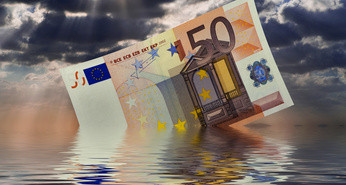Is the bad news from Greece and Spain finally pushing the euro lower? EUR/USD is now dipping below the critical line of 1.2945 which successfully cushioned the pair earlier in the week.
The break is not confirmed yet, and could be false, but it’s the lowest since January.
EUR/USD is now at 1.2934, below the 1.2945 line and below 1.2955 it traded early on Monday. The pair opened with a gap. It never managed to close the gap, which was a bearish sign. It also dropped below uptrend support.

EUR USD Below Critical Support – Click image to enlarge
Spanish Credit Crunch
Spanish yields are finally rising, reacting to the severe situation of the Spanish banking system: the Rajoy government could inject 10 billion euros to the ailing Bankia. The bigger picture is more scary: most Spanish institutions have no market access.
Spain now has a choice of picking up the banks’ debt like in Ireland or letting them fall like in Iceland. This critical decision will have a short term and long term impact.
In Greece, it is becoming clear that a second round of elections is due in June: either 10th or 17th. The May 6th elections left a deadlock. Voters will have a choice between continuing the current austerity/ bailout path or treating it as “null and voidâ€, quoting from the leader of SYRIZA, the prominent leftist anti-bailout party.
In the meantime, uncertainty rises. Will this take a deeper toll on the euro? Up to now, it has kept up rather nicely despite all the bad news. Michael Derks provides some explanations.
Yet unless there is some magic bazooka, firewall, QE or any other magic trick, the relative strength of the common currency will likely be challenged sooner rather than later. It might be happening now.
For more, see the EUR/USD forecast.



